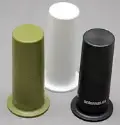Blog Information
- Posted By : Jett Blaze
- Posted On : Jan 03, 2024
- Views : 90
- Category : General
- Description : Choosing the right aviation antenna is the first step in upgrading your aircraft’s communication system. Multiple factors determine the selection of an optimal model. These factors include operational needs and the airplane itself. Seeking improved safety? Extended range? Advanced inflight entertainment? Follow these tips for informed aircraft band antenna buying.
Overview
Choosing the right aviation antenna is the first step in upgrading your aircraft’s communication system. Multiple factors determine the selection of an optimal model. These factors include operational needs and the airplane itself. Seeking improved safety? Extended range? Advanced inflight entertainment? Follow these tips for informed aircraft band antenna buying.
Understand Relevant Frequencies
Civilian planes primarily use VHF antenna frequencies between 118–137 MHz for navigation and transmission to ground stations. Commercial jets integrate UHF from 225–400 MHz for onboard wifi and connectivity. And GPS navigation relies on signals at 1575 MHz.
So first, identify what band(s) an antenna must cover for interfacing with your avionics equipment. Aviation antennas specified for Airband or VHF mobile provide the essentials. Combine models if both civil and military-grade communication abilities border on 400 MHz are needed.Choose Directional vs Omnidirectional

Omnidirectional antennas radiate and receive evenly across 360 degrees. This versatile coverage works well for both transmission and reception without needing precise aiming.
S-Band Directional Antenna focuses the signal into a tighter beam. It extends the range in specific directions. High-gain directional aircraft antennas help strengthen inflight communication with distant ground towers or satellites.
Consider Antenna Gain
An aviation antenna’s “gain” indicates signal power — higher gain means farther reach. But note directionals with 7–9 dBi gain have very focused beams requiring precise pointing.
2–4 dBi gains are usually good for general aviation. They don’t require narrow tuning.
Use Quality Cabling
The connecting coaxial cable carries radio signals between an antenna and the interior transceiver. RG-400 cables efficiently handle high-power transmissions without signal loss. Or invest in durable Teflon jacketing for cables exposed on external antenna mounts.
Ensure Durability
Aircraft antennas endure substantial mechanical stress from vibration, wind, and temperature extremes. Certified models have rugged internal construction. They also have weatherproof housings. These housings are made of sealed aluminum alloy or reinforced composites. They can survive airborne conditions.
Perform Ground Testing
Before the first flight, use an SWR meter to tune the newly mounted antenna for optimal impedance against the transceiver frequency. This “standing wave ratio” check confirms everything is integrated properly for safe operation. Consider ordering a spare antenna as a backup.
Explore Custom-Engineering Options
A fully customized antenna design remains the most reliable route for specialized avionics requirements. Aviation Band Preamplifier allows the development of a solution tuned precisely to your plane model. It also considers equipment specs, operating frequencies, and directional needs. This is for peak inflight performance.
Work closely with an aviation integration expert. Plan custom antenna specs. Do 3D modeling. Prototype the system. Conduct rigorous real-world testing. Then, manufacture your optimized system.
Trust the Antenna Experts
Upgrading flight communication is smoother when partnering with avionics specialists. They combine deep RF engineering expertise with a passion for aviation.
Antennas.us has been trusted for over 65 years. They create tailored antenna solutions and advise on ideal setups. This helps maximize inflight safety and efficiency. They rely on their full-service custom design, manufacturing, and installation capabilities. These capabilities support private through commercial aircraft worldwide.
